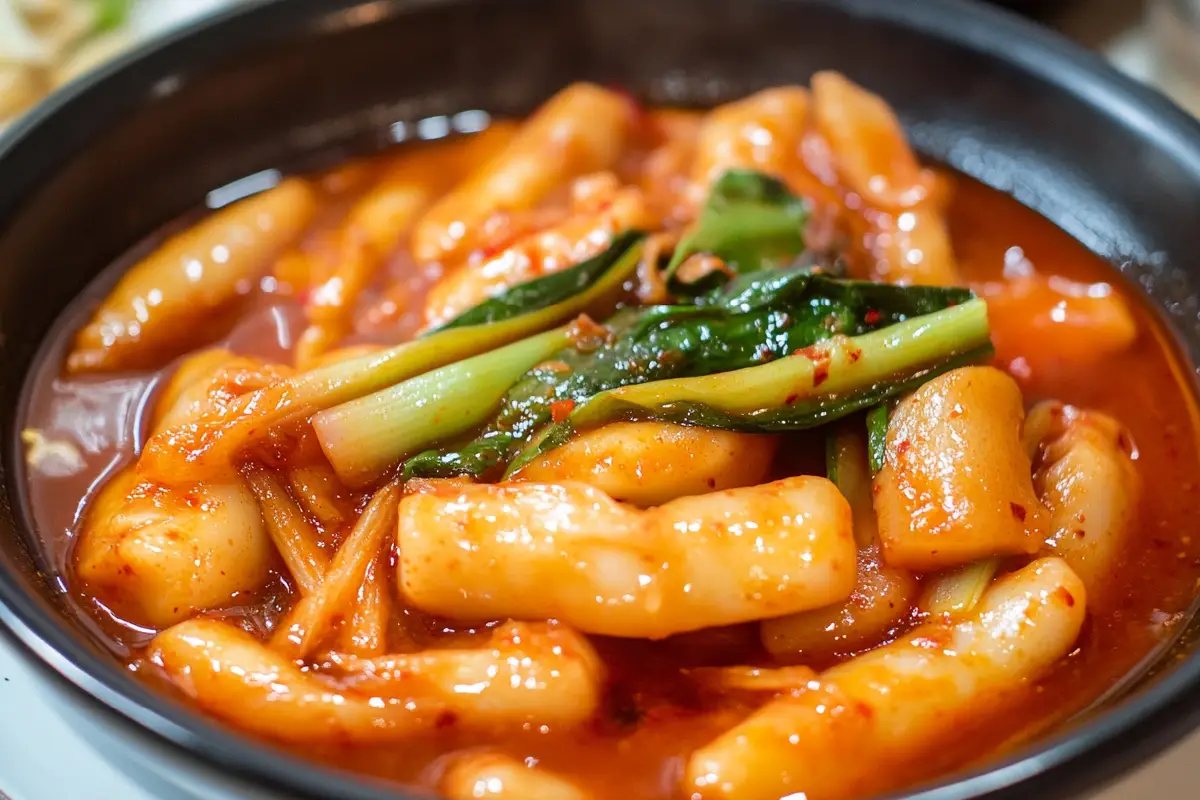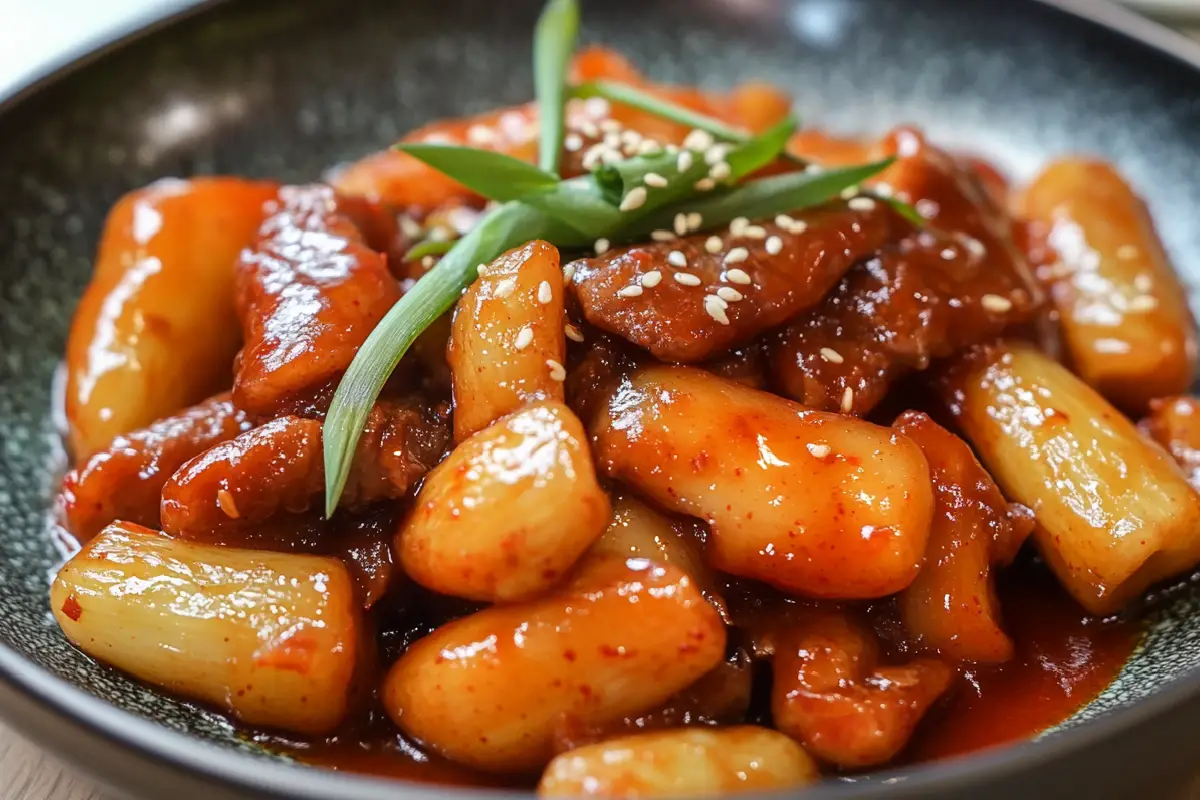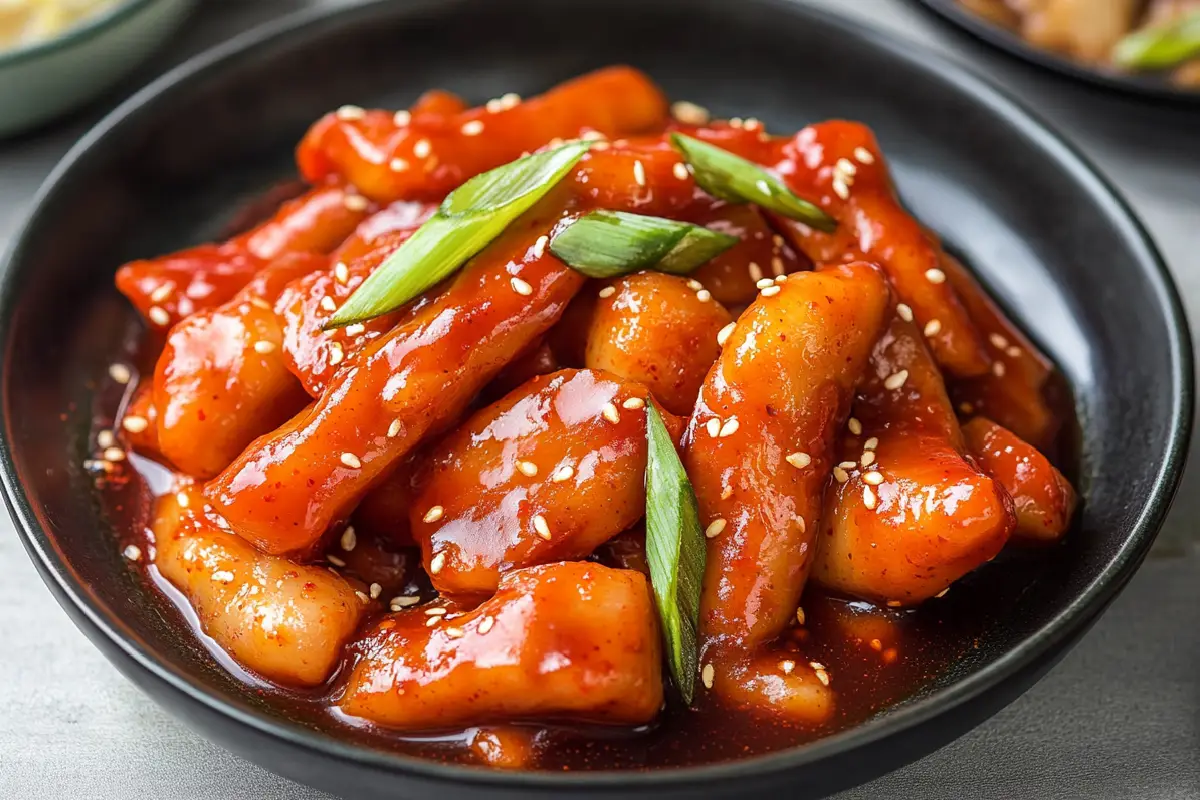What Does Tteokbokki Mean in English?
Korean food is full of rich flavors and exciting dishes, with tteokbokki being one of the most loved. But what does tteokbokki mean in English? In simple terms, the word tteokbokki comes from two Korean words: tteok (떡), which means rice cakes, and bokki (볶이), which means stir-fried. So, tteokbokki translates to “stir-fried rice cakes.”
These rice cakes are made from glutinous rice flour, which gives them a chewy texture. While the name may sound basic, tteokbokki is much more than just stir-fried rice cakes. It’s a popular Korean dish known for its bold flavors, often cooked in a spicy, savory sauce made with gochujang (Korean chili paste). This dish is commonly enjoyed as a snack or light meal, both at street food stalls and in homes throughout Korea.
Moreover, tteokbokki is versatile. It can be found in a variety of styles, from the traditional spicy version to modern takes that include cheese or cream. Whether you’re exploring Korean street food or making it at home, tteokbokki offers a taste of Korea’s food culture that’s both satisfying and easy to enjoy.
A Brief History of Tteokbokki
From Royalty to Street Food
Tteokbokki has a long history, with its origins dating back to Korea’s Joseon Dynasty (1392–1897). Back then, tteokbokki was known as gungjung tteokbokki or “royal court stir-fried rice cakes.” This version was not spicy; instead, it was made with a soy sauce-based marinade and served with sliced beef and vegetables. It was a dish enjoyed by Korean royals and elites.
Fast forward to the 1950s, the tteokbokki we know today was born—by accident! A street vendor in Seoul reportedly dropped rice cakes into a pot of spicy gochujang sauce. The combination of chewy rice cakes and the fiery chili paste was a hit, and spicy tteokbokki quickly became one of Korea’s most popular street foods.
Now, tteokbokki is not only a comfort food but also a dish enjoyed by people of all ages and backgrounds. You can find it in street stalls, restaurants, and even in Korean grocery stores around the world.
Key Ingredients in Tteokbokki

The ingredients that make up tteokbokki are simple yet carefully balanced to create its signature flavor. Here’s a breakdown of the key components that make this dish so special:
- Rice cakes (tteok): The star of the dish. These rice cakes are soft, chewy, and made from glutinous rice flour. They provide the dish’s satisfying texture.
- Gochujang: This fermented red chili paste is central to many Korean dishes, and tteokbokki is no exception. It’s what gives the dish its characteristic spicy, sweet, and slightly tangy flavor.
- Fish cakes (eomuk): Sliced fish cakes add a savory, umami flavor and additional texture. These are common in street food versions of tteokbokki.
- Broth: The sauce is typically made with a broth base—most commonly anchovy or kelp broth, which adds depth and enhances the umami flavors.
- Vegetables and Garnishes: Cabbage, onions, and scallions are often added for flavor and texture, while boiled eggs and sesame seeds are popular garnishes.
Together, these ingredients form a dish that is both bold and comforting. The balance of heat from the gochujang, the chewiness of the rice cakes, and the savory elements from the broth and fish cakes make tteokbokki a perfect snack or meal.
How to Make Tteokbokki at Home
Making tteokbokki at home is surprisingly easy. Follow these steps to enjoy this iconic dish in your kitchen.
Ingredients:
- 400g tteok (Korean rice cakes)
- 3 tablespoons gochujang (Korean chili paste)
- 2 tablespoons soy sauce
- 1 tablespoon sugar
- 2 cups anchovy or vegetable broth
- 100g fish cakes, sliced
- 1 onion, sliced
- 2 scallions, chopped
- 2 boiled eggs (optional)
- Sesame seeds for garnish
Instructions:
- Soak the rice cakes: If using refrigerated or frozen rice cakes, soak them in warm water for about 20 minutes to soften them.
- Prepare the broth: In a large pot, bring the anchovy broth to a simmer. If you don’t have anchovy broth, you can use water or vegetable broth instead.
- Make the sauce: Add the gochujang, soy sauce, and sugar to the broth. Stir until well combined, letting the sauce simmer for a few minutes.
- Cook the rice cakes and fish cakes: Add the softened rice cakes and fish cakes to the sauce. Simmer everything together for 10–15 minutes, stirring occasionally, until the sauce thickens and the rice cakes become soft and chewy.
- Add vegetables: Stir in the onion and scallions. Let everything cook for another 5 minutes.
- Serve: Garnish with sesame seeds and add boiled eggs if you like. Serve the dish piping hot!
For a creamier variation, you can add cheese on top at the end and let it melt over the rice cakes.
Regional Variations of Tteokbokki
Tteokbokki is a versatile dish with many regional and modern variations. While the classic spicy version remains the most popular, here are some other versions you may encounter:
1. Gungjung Tteokbokki (Royal Court Tteokbokki)
As mentioned earlier, gungjung tteokbokki is the original version of the dish. Instead of a spicy sauce, this version uses soy sauce and is stir-fried with vegetables and beef. It’s mild, savory, and has a more traditional, royal taste.
2. Rose Tteokbokki
This modern version combines gochujang with heavy cream or milk to create a creamy, less spicy sauce. Rose tteokbokki has become very popular, especially with those who enjoy a creamier, richer taste.
3. Cheese Tteokbokki
A favorite among younger generations, cheese tteokbokki includes melted cheese that adds a creamy, savory layer on top of the spicy sauce. It’s a perfect combination for those who love cheesy comfort food.
4. Jajang Tteokbokki
This version uses jajangmyeon sauce, a black bean paste commonly used in Korean-Chinese dishes. The result is a rich, umami-packed sauce that’s less spicy but equally flavorful.
5. Seafood Tteokbokki
In coastal cities like Busan, you’ll often find tteokbokki with added seafood such as shrimp, squid, or clams. The seafood adds a fresh, briny flavor to the dish, elevating it to a new level.
Tteokbokki as a Global Street Food
In Korea, tteokbokki is an iconic street food. Vendors sell it in bustling markets and from small street carts, offering warm bowls of this spicy, chewy snack to passersby. But it’s not just limited to Korea anymore. Thanks to the global popularity of Korean culture—particularly K-pop, Korean dramas, and movies—Korean food, including tteokbokki, has become a global sensation.
International food festivals, Korean restaurants, and even food trucks around the world now feature tteokbokki on their menus. Its spicy, comforting nature appeals to food lovers everywhere. You can also find tteokbokki kits in many international grocery stores, making it easier than ever to enjoy this dish at home, no matter where you are.
Nutritional Value of Tteokbokki
While tteokbokki is delicious, it’s also important to know what’s in it, especially if you’re mindful of your diet. Here’s a breakdown of the nutritional value for one serving of classic tteokbokki (around 250g):
- Calories: 300-500 kcal, depending on the ingredients.
- Carbohydrates: 50-70g, mainly from the rice cakes.
- Protein: 6-15g, especially if you add fish cakes or eggs.
- Fat: 5-15g, depending on the amount of oil or cheese added.
Tteokbokki is high in carbohydrates due to the rice cakes, which makes it a filling dish. However, it can be low in protein unless you add ingredients like fish cakes, seafood, or eggs. For a more balanced meal, pair tteokbokki with vegetables or add more protein-rich toppings.
Healthier Tteokbokki Options
If you love tteokbokki but want a healthier version, here are a few tips to lighten up the dish:
- Use less sugar: You can reduce the sugar in the sauce or replace it with a natural sweetener like honey or stevia.
- Add more vegetables: Boost the nutritional value by adding more vegetables like spinach, zucchini, or mushrooms.
- Opt for a low-sodium broth: Use a broth with lower sodium content to keep the dish heart-healthy.
- Try brown rice cakes: While harder to find, brown rice cakes are available in some stores and provide more fiber than traditional white rice cakes.
These small adjustments can help you enjoy tteokbokki more often without feeling guilty.
FAQs about What Does Tteokbokki Mean in English

1. What does “tteokbokki” mean in English?
In English, tteokbokki means “stir-fried rice cakes.”
2. Is tteokbokki always spicy?
No, while the classic version uses gochujang and is spicy, there are milder versions like gungjung tteokbokki that use soy sauce instead.
3. Can I eat tteokbokki as a full meal?
Yes, by adding ingredients like fish cakes, seafood, or eggs, you can turn tteokbokki into a more balanced, filling meal.
4. How should I store leftover tteokbokki?
You can store leftover tteokbokki in an airtight container in the refrigerator for up to three days. When reheating, add a bit of water or broth to refresh the sauce.
Conclusion – What Does Tteokbokki Mean in English?
Tteokbokki is a dish that has stood the test of time, transforming from a royal delicacy to an everyday street food enjoyed by millions. Its chewy rice cakes, bold flavors, and spicy-sweet sauce make it an irresistible dish that’s easy to prepare and enjoy. Whether you prefer it spicy or mild, with cheese or seafood, tteokbokki offers endless possibilities for customization.
As the global love for Korean food continues to grow, tteokbokki remains at the forefront, winning over new fans every day. Whether you’re enjoying it from a street vendor in Seoul or making it in your own kitchen, tteokbokki is a dish that never fails to deliver bold, comforting flavors.

